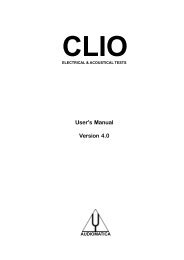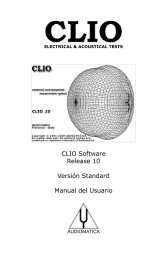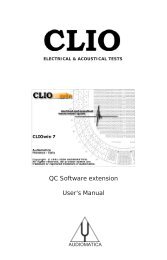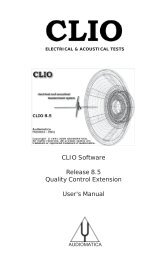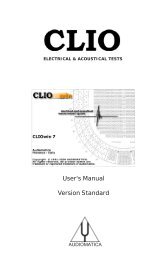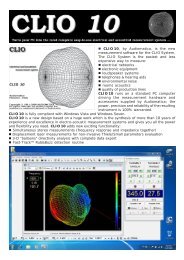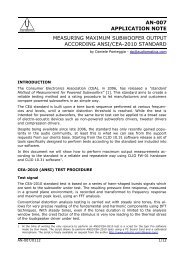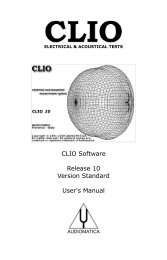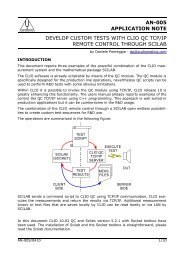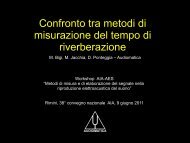CLIOwin 6.5 PCI User's Manual - Audiomatica Srl
CLIOwin 6.5 PCI User's Manual - Audiomatica Srl
CLIOwin 6.5 PCI User's Manual - Audiomatica Srl
You also want an ePaper? Increase the reach of your titles
YUMPU automatically turns print PDFs into web optimized ePapers that Google loves.
This operating mode is very useful; as an example suppose you want to measure the<br />
total harmonic distortion of a sinusoidal signal while displaying also its frequency<br />
content. To do this lets invoke the FFT and Multi-meter control panels together; then<br />
press the Go button in FFT, this will start both measurements (see also 8.6 about this);<br />
inside the Multi-meter select the THD parameter and then press the minimized button.<br />
You should obtain a measurement situation like the one in Fig.8.3. In this figure we were<br />
acquiring directly the output of CLIO while generating a 1kHz sinusoid at 0dBu.<br />
Figure 8.3<br />
8.3.3 CAPTURING THE GLOBAL REFERENCE LEVEL<br />
Let's see now how to capture a level to be the reference for other measurements. Once<br />
this is done then the subsequent measures done in all the instrument, with the units<br />
dBRel selected, will refer to it. As an example we go back to the procedure described<br />
in 3.5.1 which aims at validating a calibration. This is substantially the measurement<br />
of the frequency response of the CLIO board itself which is, when calibrated, a straight<br />
line; as said in the cited procedure the acquired level of such a measurement is -5.2 dBV.<br />
Let's see a practical way to acquire this level in order to refer future measurements to<br />
it. Maintain the instrument connected as in Fig.3.9, with input A and output A short<br />
circuited. Press the MLS button to start generating the MLS signal (the same that MLS<br />
uses during its operation). Press Go to start acquiring this signal, you should read circa<br />
0.54V. Select also the Slow integration as the MLS signal is a wide band noise. While<br />
the measurement is running press the button; answering yes to the warning<br />
message you'll set the global reference level. To inspect the captured value press the<br />
button's drop down menu. You should see the situation in Fig.8.4.<br />
Figure 8.4<br />
The drop down tells you what is the actual global reference level. If you want to restore<br />
the default , which is 1V, just choose Reset. Should you choose now, as reading units,<br />
dBRel expect to read 0dBRel!<br />
72 Chapter 8 - Multi-Meter



